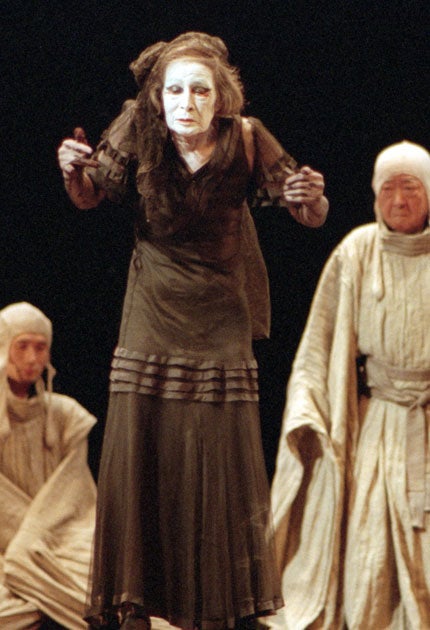Kazuo Ohno: Dancer who co-founded the modern Butoh style and brought it to the world stage

Kazuo Ohno was the co-founder of Butoh, the Japanese dance form which is influenced by Japanese traditions and modern Western dance and is inspired both by Japanese and foreign literature. With its playful and grotesque imagery, taboo topics, characters with whitened faces, its slow movements and physical distortions, Butoh was a reaction in part to the horrors sustained by Japan during the Second World War and the uncertainties of the post-war nuclear era.
Ohno continued performing even after illness ravaged his body. His solo performances were not only dramatic and expressive but also haunting and fraught with ambiguity. His characters were identifiable – often flamboyant women – and he blended humour with emotional intensity. His body twisted and grotesque, he would often portray tottering women,fragile creatures with flapping shoes and skewed wigs.
Born in Hakodate, Hokkaido Prefecture, in 1906, Kazuo Ohno was the son of a Russian-speaking father who was head of the local fisherman's co-operative; his mother was a musician and an expert in European cuisine. Ohno was not particularly academic but excelled in athletics and in 1926 went to the Japan Athletic College in Tokyo, where he dominated. His life changed, when he went to the Imperial Theatre to see a performance by the Spanish flamenco dancer Antonia Mercé, known as La Argentina, ("The Queen of the Castanets").
On graduating in 1929, Ohno worked as a physical education instructor in a private Christian school in Yokohama. Thereafter, he went to Soshin Girls' School, another Christian school where he was expected to teach dance (he retired from there in 1980). He began training with two of Japan's modern dance pioneers, Baku Ishii and Takaya Eguchi; the latter had studied Neue Tanz with the German Expressionist Mary Wigman.
Japan was at war with China and in 1938 Kazuo was drafted into the army as a lieutenant, rising to captain. He fought in China and New Guinea, where he was captured and interned by the Australians as a POW. The war and its horrors, would provide Ohno with inspiration for some of his later works, such as Jellyfish Dance, thought to be a meditation on the burials at sea he had observed on board the ship transporting soldiers back to Japan.
On his return to Japan, Ohno resumed his dance studies and, aged 43, presented his first recital, a joint performance with Mitsouko Ando, in Tokyo in 1949. The artist Tatsumi Hijikata was mesmerised by Ohno's performance that night, and their destinies became entwined. A year later he gave his first solo performance.
Hijikata invited Ohno to join his dance collective. With Ohno as his muse, Hijikata spent the next several years developing Ankoku Butoh-ha – "the dance of utter darkness", which later became Butoh. The two collaborated from 1959 until Hijikata's death in 1986. Their pieces were derived from Western as well as Japanese authors, such as Jean Genet, Comte de Lautréamont, Ernest Hemingway and Yukio Mishima. In 1959, Hijikata created one of the earliest Butoh works, Kinjiki [Forbidden Colours]. Based on the novel by Mishima it explored homosexuality and paedophilia and caused uproar.
Hijikata directed many of Ohno's solo performances, the first, Divine, a tribute to the dying transvestite prostitute from Jean Genet's subversive 1943 novel Our Lady of the Flowers. Despite their collaboration, the two adopted different approaches. While Hijikata's work was often violent and provocative, Ohno's was gentler and more emotional. Ohno once said, "The best thing someone can say to me is that while watching my performance they began to cry. It is not important to understand what I am doing; perhaps it is better if they don't understand, but just respond to the dance."
Ohno continued performing with Hijikata and other Japanese modern-dance and Butoh artists, including his sons. Between 1969 and 1973 he had starring roles in three films by Chiaki Nagano, while in 1977, inspired by his visit to see Mercé nearly 50 years earlier, Ohno premiered his solo Butoh work La Argentina Sho [Admiring La Argentina], which was awarded the Dance Critic's Circle Award and was widely regarded as a classic.
He began performing internationally in 1980 when he appeared at the 14th International Festival in Nancy. His major pieces included My Mother, Water Lilies and The Road in Heaven, the Road in Earth. Over the next two decades he performed worldwide and used his travels for inspiration. While in Israel in 1983 he performed The Dead Sea with his son Yoshito, who also directed him over the last 20 years of his career.
Despite deteriorating health, Ohno remained active virtually his entire life. His last international performance was in 1999 at the Japan Society, New York, where he presented a retrospective called Requiem for the 20th Century. His last Japanese performances were in 2007. Aged 101, he sometimes "danced" with his hands alone or crawled on all fours to communicate with his audience, making use of the working parts of a body ravaged by illness and age – perhaps the perfect metaphor for the dark art of Butoh.
Kazuo Ohno, dancer; born Hakodate, Japan 27 October 1906; married 1933 Chie Nakagawa (died 1997; two sons); died Yokohama City 1 June 2010.
Subscribe to Independent Premium to bookmark this article
Want to bookmark your favourite articles and stories to read or reference later? Start your Independent Premium subscription today.

Join our commenting forum
Join thought-provoking conversations, follow other Independent readers and see their replies